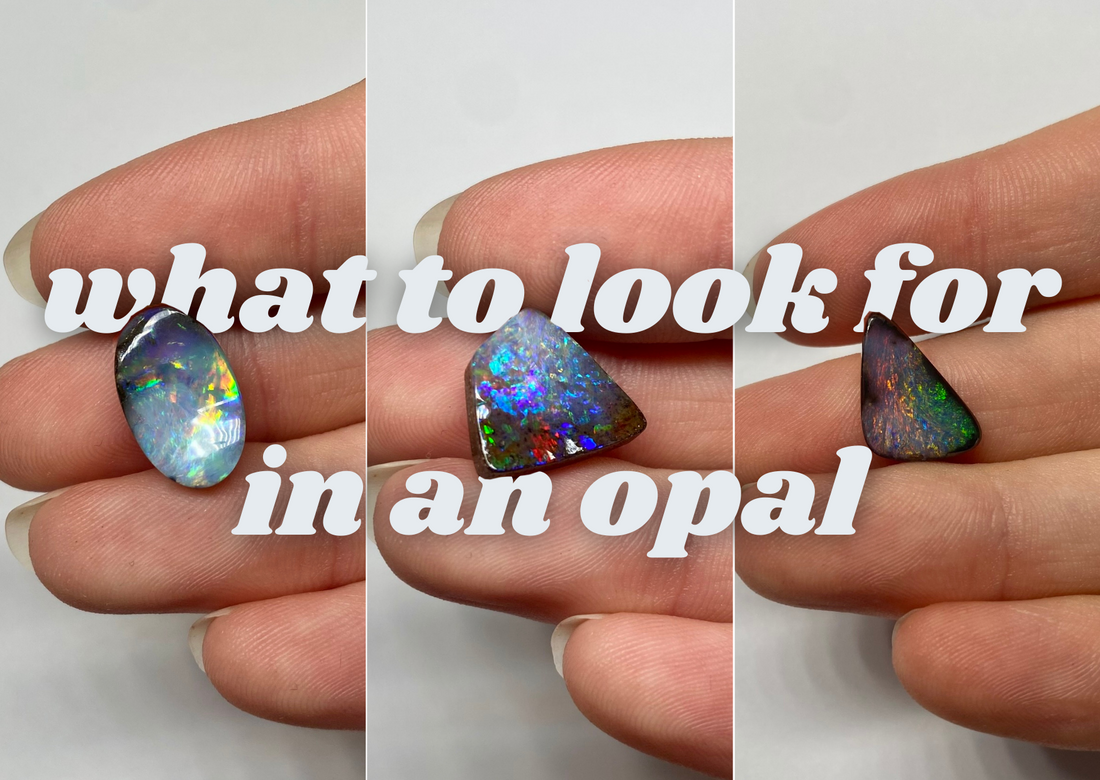Firstly, why opals?
Opals are a unique and captivating gemstone that have been prized for centuries for their stunning beauty and vibrant colors. Known for their mesmerising displays of colours, opals are considered quite rare with each opal possessing a one-of-a-kind pattern and color combination. They are a great stone for jewellery as their variety of shapes, sizes, and colors, allow for endless design possibilities. Overall, opals have a timeless appeal that transcends trends.
So let's dive into the characteristics that you should look out for when choosing an opal for your jewellery.
Colour
For opals, colour is the most influential factor when determining their quality and value. One reason why opals have such a unique lure is because of the many colours each stone displays. The purity of hues and saturation is also a key factor to look out for with opals possessing purer hues with bright saturation being more desirable. Another element of an opals colour is the "body tone" (the base colour of the opal). These usually appear as dark (black) or light (white). Often, opals with darker body tones allow the colours in the opal to appear more vibrantly.
The presence of a vibrant rainbow display within the stone, known as the "play-of-colour" is what graders are looking out for when grading opals. This takes into consideration the previously mentioned elements of colour (purity of hues, saturation, body tone, brightness, etc.).
Clarity
Another area that informs an opal's value is clarity. But what does clarity mean exactly? Clarity is determined by two main factors appearance and inclusions.
Appearance overlaps in some way with colour as it looks at saturation, hue and tone of the colours. In terms of clarity though, this looks more specifically at the clarity of the colour, whether it is a crisp, brilliant and brightly coloured gemstone or it has a more milky appearance. Bright opals tend to be valued more highly than ones with a milky appearance.
Inclusions (can also known as "flaws") refer to anything included in the opal that impact the opals appearance or clarity. This may include fractures, cracks, sandstone/ironstone, or matrix. The presence of any of these inclusions influences the clarity of the opal.
The level of transparency an opal has also plays into this as you are more likely to see and notice inclusions in a transparent opal rather than a completely opaque one. Generally speaking, more transparent opals are generally less valuable than opaque opals (unless they are a specific type of opal like crystal opals).
Size
Both dimensions and carat weight also play a role in choosing an opal. The dimensions of an opal refer to its physical size, including length, width, and thickness. In general, larger opals tend to exhibit more vibrant colours and a more pronounced play-of-color. This is because larger opals have a greater surface area for light to interact with the internal structure of the gemstone, resulting in a more dazzling display of colors.
Carat weight is a measure of the mass of a gemstone. When it comes to opals, a higher carat weight often indicates a larger and more valuable gemstone. However, carat weight alone does not determine the quality of an opal, however the play-of-colour is much more indicative of an opals value.
Where they're from
Opals are found all over the world, however some locations are known for opals that are of a higher standard. Australian opals are renowned for possessing a higher quality, with some opal varieties only being found in some areas of Australia making them even more valuable. Australia also has a good reputation for quality opals around the globe, so when you see an Australian opal, you know it is one of the best.
Knowing what and understanding all of these elements makes each opal appear all the more unique. It gives you the eye to see their differences and also have a better understanding of why an opal is priced the way it is.

